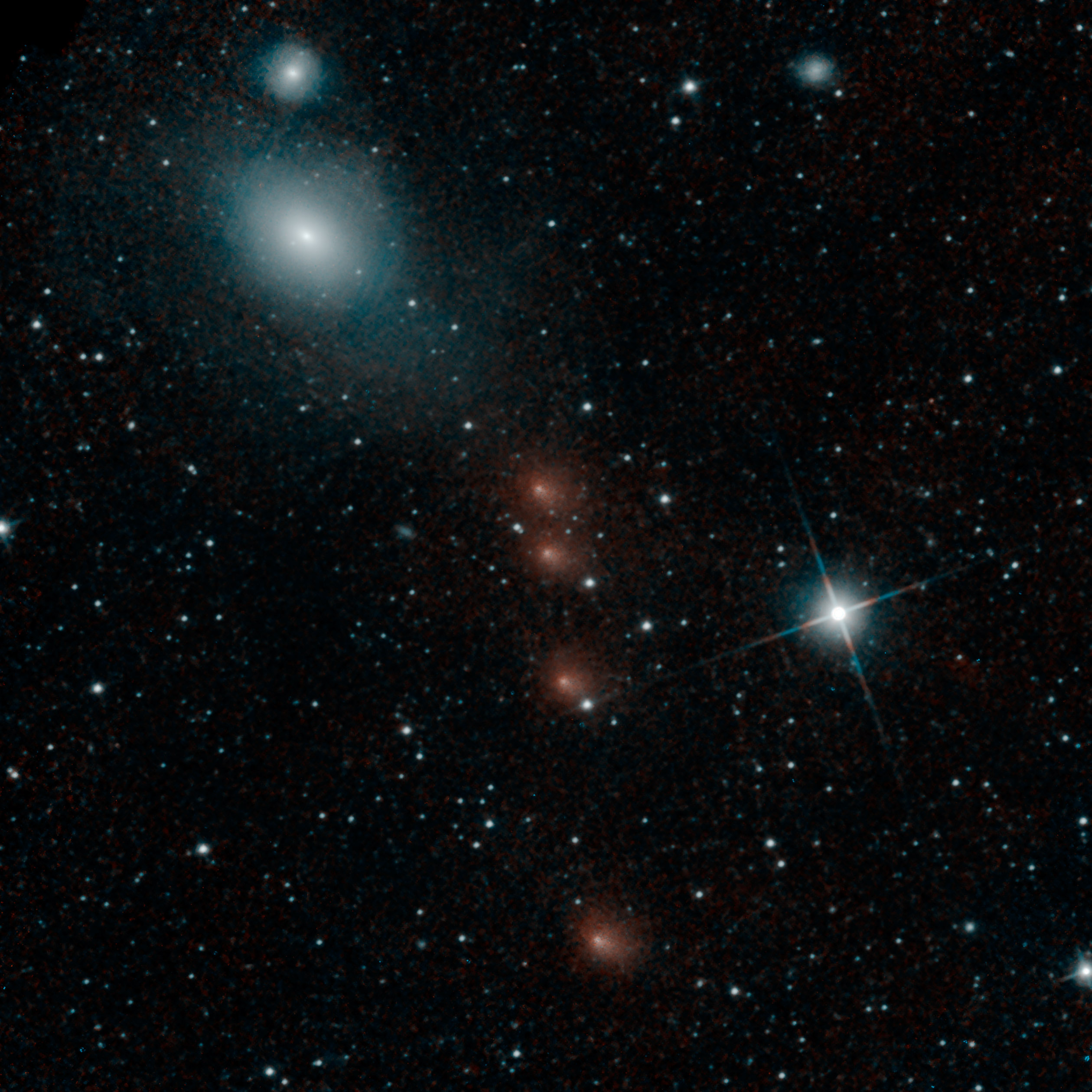|
3628 Božněmcová
3628 Božněmcová, provisional designation , is a rare O-type asteroid from the middle region of the asteroid belt, approximately 7 kilometers in diameter. It was discovered on 25 November 1979, by Czech astronomer Zdeňka Vávrová at Kleť Observatory in the Czech Republic. It is named for Czech writer Božena Němcová. Orbit and classification ''Božněmcová'' orbits the Sun in the central main-belt at a distance of 1.8–3.3 AU once every 4.04 years (1,477 days). Its orbit has an eccentricity of 0.30 and an inclination of 7 ° with respect to the ecliptic. It was first identified as at Lowell Observatory in 1930, extending the body's observation arc by 49 years prior to its official discovery observation at Klet. Physical characteristics In the SMASS taxonomy, ''Božněmcová'' is a bright O-type asteroid, a rare group with spectra that best fits those of the L6 and LL6 ordinary chondrite-type meteorites. Rotation period In September 2007, a rotationa ... [...More Info...] [...Related Items...] OR: [Wikipedia] [Google] [Baidu] |
Kleť Observatory
Kleť Observatory (; obs. code: 046) is an astronomical observatory in the Czech Republic. It is situated in South Bohemia, south of the summit of Mount Kleť, near the town of České Budějovice. Constructed in 1957, the observatory is at an altitude of and has around 150 clear nights per year. Astronomers Astronomer Antonín Mrkos became director of Kleť Observatory in 1965. Two main astronomers who currently work at Kleť Observatory are Jana Tichá and her husband Miloš Tichý. Instruments The observatory has two primary telescopes: * 1.06-m KLENOT telescope (since 2002) * 0.57-m f/5.2 reflector (since 1993) Gallery File:Mount Klet.jpg, Summit of Mount Kleť, the observatory is visible on the left File:Jana Tichá, Miloš Tichý and KLENOT.jpg, Jana Tichá, Miloš Tichý and KLENOT in 2004 File:Výlet na Klet - 28 srpna 2009 116.JPG, Telescope Discoveries As of 2015 over a thousand asteroids were discovered at Kleť Observatory, as well as comet 1 ... [...More Info...] [...Related Items...] OR: [Wikipedia] [Google] [Baidu] |
Lowell Observatory
Lowell Observatory is an astronomical observatory in Flagstaff, Arizona, United States. Lowell Observatory was established in 1894, placing it among the oldest observatories in the United States, and was designated a National Historic Landmark in 1965. and In 2011, the Observatory was named one of "The World's 100 Most Important Places" by Time Magazine. It was at the Lowell Observatory that the dwarf planet Pluto was discovered in 1930 by Clyde Tombaugh. The observatory was founded by astronomer Percival Lowell of Boston's Lowell family and is overseen by a sole trustee, a position historically handed down through the family. The first trustee was Lowell's third cousin Guy Lowell (1916–1927). Percival's nephew Roger Putnam served from 1927 to 1967, followed by Roger's son Michael (1967–1987), Michael's brother William Lowell Putnam III (1987–2013), and current trustee W. Lowell Putnam. Multiple astronauts attended the Lowell Observatory in 1963 while the moon was ... [...More Info...] [...Related Items...] OR: [Wikipedia] [Google] [Baidu] |
Astronomical Albedo
Albedo ( ; ) is the fraction of sunlight that is diffusely reflected by a body. It is measured on a scale from 0 (corresponding to a black body that absorbs all incident radiation) to 1 (corresponding to a body that reflects all incident radiation). ''Surface albedo'' is defined as the ratio of radiosity ''J''e to the irradiance ''E''e (flux per unit area) received by a surface. The proportion reflected is not only determined by properties of the surface itself, but also by the spectral and angular distribution of solar radiation reaching the Earth's surface. These factors vary with atmospheric composition, geographic location, and time (see position of the Sun). While directional-hemispherical reflectance factor is calculated for a single angle of incidence (i.e., for a given position of the Sun), albedo is the directional integration of reflectance over all solar angles in a given period. The temporal resolution may range from seconds (as obtained from flux measurements) to ... [...More Info...] [...Related Items...] OR: [Wikipedia] [Google] [Baidu] |
NEOWISE
Wide-field Infrared Survey Explorer (WISE, observatory code C51, Explorer 92 and MIDEX-6) was a NASA infrared astronomy space telescope in the Explorers Program launched in December 2009.. . WISE discovered thousands of minor planets and numerous star clusters. Its observations also supported the discovery of the first Y-type brown dwarf and Earth trojan asteroid. ... . WISE performed an all-sky astronomical survey with images in 3.4, 4.6, 12 and 22 μm wavelength range bands, over ten months using a diameter infrared telescope in Earth orbit. After its solid hydrogen coolant depleted, it was placed in hibernation mode in February 2011. In 2013, NASA reactivated the WISE telescope to search for near-Earth objects (NEO), such as comets and asteroids, that could collide with Earth. The reactivation mission was called Near-Earth Object Wide-field Infrared Survey Explorer (NEOWISE). As of August 2023, NEOWISE was 40% through the 20th coverage of the full sky. Science o ... [...More Info...] [...Related Items...] OR: [Wikipedia] [Google] [Baidu] |
Wide-field Infrared Survey Explorer
Wide-field Infrared Survey Explorer (WISE, List of observatory codes, observatory code C51, Explorer 92 and MIDEX-6) was a NASA infrared astronomy Space observatory, space telescope in the Explorers Program launched in December 2009.. . WISE List of minor planet discoverers#WISE, discovered thousands of minor planets and numerous star clusters. Its observations also supported the discovery of the first Y dwarf, Y-type brown dwarf and Earth trojan, Earth trojan asteroid. ... . WISE performed an all-sky astronomical survey with images in 3.4, 4.6, 12 and 22 μm wavelength range bands, over ten months using a diameter infrared telescope in Geocentric orbit, Earth orbit. After its solid hydrogen coolant depleted, it was placed in Hibernation (spaceflight), hibernation mode in February 2011. In 2013, NASA reactivated the WISE telescope to search for near-Earth objects (NEO), such as comets and asteroids, that could collide with Earth. The reactivation mission was called Near-Eart ... [...More Info...] [...Related Items...] OR: [Wikipedia] [Google] [Baidu] |
Akari (satellite)
AKARI (ASTRO-F) was an infrared astronomy satellite developed by Japan Aerospace Exploration Agency, in cooperation with institutes of Europe and Korea. It was launched on 21 February 2006, at 21:28 UTC (06:28, 22 February JST) by M-V rocket into Earth Sun-synchronous orbit. After its launch it was named ''AKARI'' (明かり), which means ''light'' in Japanese. Earlier on, the project was known as IRIS (InfraRed Imaging Surveyor). Its primary mission was to survey the entire sky in near-, mid- and far-infrared, through its aperture telescope. Technical design Its designed lifespan, of far- and mid-infrared sensors, was 550 days, limited by its liquid helium coolant. Its telescope mirror was made of silicon carbide to save weight. The budget for the satellite was ¥13,4 billion (~). History By mid-August 2006, AKARI finished around 50 per cent of the all sky survey. By early November 2006, first (phase-1) all-sky survey finished. Second (phase-2) all-sky survey starte ... [...More Info...] [...Related Items...] OR: [Wikipedia] [Google] [Baidu] |
LCDB Quality Code
In astronomy, a light curve is a graph of the light intensity of a celestial object or region as a function of time, typically with the magnitude of light received on the ''y''-axis and with time on the ''x''-axis. The light is usually in a particular frequency interval or band. Light curves can be periodic, as in the case of eclipsing binaries, Cepheid variables, other periodic variables, and transiting extrasolar planets; or aperiodic, like the light curve of a nova, cataclysmic variable star, supernova, microlensing event, or binary as observed during occultation events. The study of a light curve and other observations can yield considerable information about the physical process that produces such a light curve, or constrain the physical theories about it. Variable stars Graphs of the apparent magnitude of a variable star over time are commonly used to visualise and analyse their behaviour. Although the categorisation of variable star types is increasingly ... [...More Info...] [...Related Items...] OR: [Wikipedia] [Google] [Baidu] |
Magnitude (astronomy)
In astronomy, magnitude is a measure of the brightness of an astronomical object, object, usually in a defined passband. An imprecise but systematic determination of the magnitude of objects was introduced in ancient times by Hipparchus. Magnitude values do not have a unit. The scale is Logarithmic scale, logarithmic and defined such that a magnitude 1 star is exactly 100 times brighter than a magnitude 6 star. Thus each step of one magnitude is \sqrt[5] \approx 2.512 times brighter than the magnitude 1 higher. The brighter an object appears, the lower the value of its magnitude, with the brightest objects reaching negative values. Astronomers use two different definitions of magnitude: apparent magnitude and absolute magnitude. The ''apparent'' magnitude () is the brightness of an object and depends on an object's intrinsic luminosity, its Cosmic distance ladder, distance, and the Extinction (astronomy), extinction reducing its brightness. The ''absolute'' magnitude () describes ... [...More Info...] [...Related Items...] OR: [Wikipedia] [Google] [Baidu] |
Rotation Period
In astronomy, the rotation period or spin period of a celestial object (e.g., star, planet, moon, asteroid) has two definitions. The first one corresponds to the '' sidereal rotation period'' (or ''sidereal day''), i.e., the time that the object takes to complete a full rotation around its axis relative to the background stars ( inertial space). The other type of commonly used "rotation period" is the object's '' synodic rotation period'' (or ''solar day''), which may differ, by a fraction of a rotation or more than one rotation, to accommodate the portion of the object's orbital period around a star or another body during one day. Measuring rotation For solid objects, such as rocky planets and asteroids, the rotation period is a single value. For gaseous or fluid bodies, such as stars and giant planets, the period of rotation varies from the object's equator to its pole due to a phenomenon called differential rotation. Typically, the stated rotation period for a giant pl ... [...More Info...] [...Related Items...] OR: [Wikipedia] [Google] [Baidu] |
Brian D
Brian (sometimes spelled Bryan in English) is a male given name of Irish and Breton origin, as well as a surname of Occitan origin. It is common in the English-speaking world. It is possible that the name is derived from an Old Celtic word meaning "high" or "noble". For example, the element ''bre'' means "hill"; which could be transferred to mean "eminence" or "exalted one". The name is quite popular in Ireland, on account of Brian Boru, a 10th-century High King of Ireland. The name was also quite popular in East Anglia during the Middle Ages. This is because the name was introduced to England by Bretons following the Norman Conquest. Bretons also settled in Ireland along with the Normans in the 12th century, and 'their' name was mingled with the 'Irish' version. Also, in the north-west of England, the 'Irish' name was introduced by Scandinavian settlers from Ireland. Within the Gaelic-speaking areas of Scotland, the name was at first only used by professional families of Iri ... [...More Info...] [...Related Items...] OR: [Wikipedia] [Google] [Baidu] |
Lightcurve
In astronomy, a light curve is a graph (discrete mathematics), graph of the Radiance, light intensity of a celestial object or region as a function of time, typically with the magnitude (astronomy), magnitude of light received on the ''y''-axis and with time on the ''x''-axis. The light is usually in a particular frequency interval or frequency band, band. Light curves can be periodic, as in the case of eclipsing binary, eclipsing binaries, Cepheid variables, other periodic variables, and Methods of detecting extrasolar planets#Transit photometry, transiting extrasolar planets; or aperiodic, like the light curve of a nova, cataclysmic variable star, supernova, gravitational microlensing, microlensing event, or binary as observed during occultation events. The study of a light curve and other observations can yield considerable information about the physical process that produces such a light curve, or constrain the physical theories about it. Variable stars Graphs of the ap ... [...More Info...] [...Related Items...] OR: [Wikipedia] [Google] [Baidu] |






